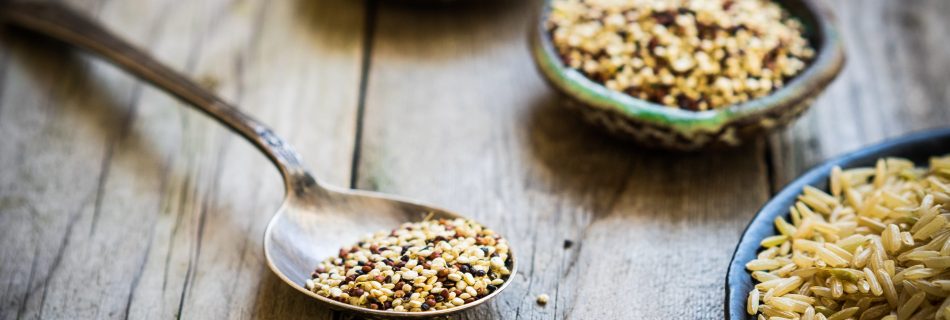Seasonal and local guide: grains

Currently, 8 cereal grains (wheat, corn, rice, barley, sorghum, oats, rye, and millet) provide 56% of the food energy and 50% of the protein consumed on earth[1]. All but rice can be grown in the UK at present because rice needs night time temps of over 15C for at least three months of the year. If kept in a cool, dark place and stored in airtight containers, grains and their flours can last many months to several years. As such, they are available to buy year-round.
The world of wheat
Modern, hybridised wheat, T. aestivum, is a hexaploid cereal that has been favoured by agriculture because it exhibits the attractive characteristic of grain kernels that thresh free of their hulls. It has the same ancestry of spelt. However studies show that T. aestivum is leading to growing gluten intolerance and could be negatively impacted by climate change in some regions. By growing grains in diverse, mixed farming systems some of these climatic effects could be buffered. To help restore biological diversity and nutrition lost through hybridisation we need to grow and consume more ancient grains.
There are three ancient wheat varieties available today that are free from hybridisation: Einkorn, Emmer and Khorasan – all within the species of Triticum. According to Shipton Mallet: “Keeping these ancient wheats alive is an important part of the stewardship of genetic diversity that will contribute greatly to the richness of our natural environment. They have a place in our food heritage, being the original domesticated grains”. But because these grains, along with spelt, all have tough, tenacious hulls that must be rubbed off with quite a bit of effort before the grains can be further processed, they are more expensive.
Ancient wheat varieties were known for their health benefits, used in alternative medicine to treat a wide range of conditions including depression, diabetes and cancer. Canadian Research is evaluating organic ancient wheat products to learn more about their nutritional and health benefits. They may also be more resilient to climate change. Spelt, for instance, performs well in low input systems, is more tolerant to climate extremes and holds promise for the organic grain food market.
Alternative grains
In a turn of good fate, less well known ancient grains such as quinoa and millet have seen a renaissance because of a growing gluten intolerance and the rise of low-carb diets.
Quinoa, originally from the Andean region of South America, is now available from UK growers. Ground into flour, quinoa is also a great alternative to wheat in baking. Along with millet, buckwheat, polenta, brown rice, sorghum, teff and brown rice, quinoa is gluten free. This super grain is a high protein alternative to rice – 100g provides 14.1g of protein, compared to 2.66g for white rice and 6.9g in brown rice; it is available to buy in the UK thanks to Hodmedod’s.
Millet requires little water and is highly drought resistant, as such it grows well in arid and semi-arid regions of the world. It favours uphill locations and can be grown in 45 days compared to 100 days for rice. It can yield two harvests per year and is resistant to pests and pathogens. This grains history is fascinating. Now a forgotten crop in the West, it was ideal for ancient shepherds and herders and semi-nomadic hunters and gathers. They carried and planted it from North China right across Eurasia, where it was mixed with crops such as wheat and barley. This gave rise to ‘multi-cropping’, which extended growing seasons and provided our ancient ancestors with food security. Millet sowed the seeds of urban living. Millet fell out of fashion during industrialisation in favour of wheat, and today is used mainly as an ingredient in birdseed.
Support local
 Grains should not be feared for their carbohydrate content but rather appreciated as a good fuel source that has been crucial in the evolution of civilization. Concerns should arise over their production and processing method, as this it seems has knock on effects to the health of people and planet. Where possible, support UK farms that grow ancient grains and are working with or towards a mixed farming agroecological system. Choose minimally processed grain-based slow foods like sourdoughs and eat fewer heavily processed cakes and bread (e.g. the Chorley loaf) that use modern wheat. All of our flour suppliers and bread makers, from Doves to Shipton Mill and Hobbs House, promote agroecological farming methods that conserve ancient grains. Supporting them means supporting the preservation of species diversity.
Grains should not be feared for their carbohydrate content but rather appreciated as a good fuel source that has been crucial in the evolution of civilization. Concerns should arise over their production and processing method, as this it seems has knock on effects to the health of people and planet. Where possible, support UK farms that grow ancient grains and are working with or towards a mixed farming agroecological system. Choose minimally processed grain-based slow foods like sourdoughs and eat fewer heavily processed cakes and bread (e.g. the Chorley loaf) that use modern wheat. All of our flour suppliers and bread makers, from Doves to Shipton Mill and Hobbs House, promote agroecological farming methods that conserve ancient grains. Supporting them means supporting the preservation of species diversity.
[1] Cordain L. (1999). Cereal grains: humanity’s double edged sword. World Review of Nutrition and Dietetics, 84: 19-73.
Tags: Einkorn, Emmer, Grain, Hodmedods, Khorasan, Local food, Quinoa, wheat
